|
- Catalog (in stock)
- Back-Catalog
- Mail Order
- Online Order
- Sounds
- Instruments
- Projects
- History Face
- ten years 87-97
- Review Face
- our friends
- Albis Face
- Albis - Photos
- Albis Work
- Links
- Home
- Contact
- Profil YouTube
- Overton Network
P & C December 1998
- Face Music / Albi
- last update 03-2016
|
1. Kamungele - Bakonzo people - 6:29
2. Ekitumbwe - Banyoro people - 3:37
3. Otwenge - Alur people - 11.27
4. Okwagala - Buganda region - 5:54
5. Imbalu ... drum rhythms - Bagisu people - 5:28
6. Idra Niri - Lugbara people - 5:42
7. Kikwabanga - Buganda region - 5:29
8. Enguli - Buganda region - 5:20
9. Sumba etaara - Bakonzo people - 7:00
10. Ggangaalula - Buganda region - 4:00
11. Maya - Buganda region - 3:27
12. Serukera - fable - Buganda region - 4:08
Africa is inhabited by different ethnic groups, each with a musical tradition of its own. This is a rich traditional music heritage that has been orally transmitted from generation to generation for centuries. Despite external influences, the majority of these ethnic groups continue to value and practise their respective traditional musical styles, which in turn have to establish strong musical and cultural identities and continue to do so.
Ugandan music is generally rhythmic and the complexity of these rhythms varies due to the difference between the ethnic groups. These differences are also reflected in the varied instrumentation. Some musical genres are played on simple instruments, while others, especially the dance music, are played in ensembles of complex instrumental formation. African music is usually pentatonic, but a few tribes also use a hexatonic scale. Most of the Ugandan vocal music is accompanied by traditional instruments. The literature embedded in vocal music is purposely meant to transform the social communities, i.e. in their structural adjustment.
Although Uganda is inhabited by a large variety of ethnic groups, a broad linguistic division is usually made between the Bantu-speaking majority, who lives in the central, southern and western parts of the country, and the non-Bantu speakers, who occupy the eastern, northern and north-western part of the country (these may be sub-divided into Nilotic and Central Sudanic peoples). The first category includes the large and historically highly centralized kingdom of Buganda, the smaller western Ugandan kingdoms of Bunyoro, Nkole (Ankole) and Toro (Batooro), and the Busoga states to the east of Buganda. There are four main ethnic groups in Uganda which all have different origins. By far the largest in number the Bantus have come from Central Africa from the Cameroon Highlands or Congo Basins, include the tribes of Baganda, Banyankore, Basoga, Bakiga, Batooro, Banyoro, Banyarwanda, Bagisu, Bagwere and Bakonzo.
The peoples in the second category (they constitute less than one-tenth per cent of the population) include the Iteso, Langi, Acholi, Alur, Karimojong, Kakwa, Japadhola, Kumam, Sebei, Jonam (Nilotic language groups who comes from the north), the Nilo-Hamitics and the Metu, Madi, Lugbara, Lendu and Okebu (Central Sudanic group) in the northwest and a number of other smaller societies in the eastern part of the country.
| Region |
Tribe |
Language |
Ethnic group |
|
central and southeastern |
|
|
|
Buganda
|
Baganda (Ganda) |
Bantu (Luganda) |
Bantu |
| central eastern |
|
|
|
| Busoga |
Basoga |
Bantu |
Bantu |
| Tororo district |
Banyole |
Bantu |
Bantu |
| Tororo and Iganga district |
Basamia-Bagwe |
Bantu |
Bantu |
| Pallisa district |
Bagwere |
Bantu (Lugwere) |
Bantu |
| Pallisa and Tororo district |
Iteso |
Nilotic |
Hamites |
| Bugisu |
Bagisu |
Bantu |
Bantu |
|
Jopadhola (Luo) |
Nilotic |
Hamitas |
|
Sebei |
Nilotic |
Hamitas |
| central western |
|
|
|
| Bunyoro |
Banyoro |
Bantu |
Bantu |
| Batooro |
Batooro |
Bantu (Rutooro) |
Bantu |
| Mt. Rwenzori |
Bakonzo, Konzo |
Bantu |
Bantu |
| south western |
|
|
|
Ankole (Nkole)
|
Banyankore (Bairu, Bahima) |
Bantu |
Bantu |
|
south |
|
|
|
Kigezi
|
Bakiga |
Bantu (Rukiga) |
Bantu |
|
southwest |
|
|
|
Western Province
|
Banyarwanda (Bafumbira)
- Bahutu, Batutsi and Batwa |
Bantu (Kinyarwanda) |
Bantu |
| central northern |
|
|
|
|
Langi |
Nilotic |
Hamites |
|
Kumam |
Nilotic (Lwo) |
Hamites |
Acholi
|
Acholi (Luo-Madi) |
Nilotic (Lwo) |
Hamites |
| north eastern |
|
|
|
Karamoja
|
Karimojong |
Nilotic |
Hamites |
|
northwest |
|
|
|
| Western Nile |
Kakwa |
Nilotic |
Hamites |
| Western Nile |
Alur, Jonam (Luo) |
Nilotic |
Hamites |
| Western Nile |
Lugbara; Madi, Metu, Okebu |
Central Sudanic |
Hamites |
- see map sketch of Uganda regions
The country
The republic of Uganda is an independent nation located in East Africa astride the equator, bordered on the east by Kenya, on the south by Tanzania and Rwanda, on the west by the Democratic Republic of the Congo (ex. Zaire), and on the north by Sudan. It covers an area of 241,040 sq. km. The population is approximately 28 million, of which 66 per cent are Christians, (the Anglican, the Catholics as well as the Pentecostal Church), 18 per cent practise traditional beliefs, and 16 per cent are Muslim. There were sizeable numbers of Sikhs and Hindus in the country. The official language is English, and the capital is Kampala.
The country has many lakes and swamps. The Lake Victoria and Lake Kioga flow into the river Nile. The Lake Edward and Lake Albert are situated on the border to Congo. A large part of Uganda is flat; and there are volcanic mountains. The biggest mountain range is the Rwenzori at the border to the Congo with the highest point being the Margherita Peak on Mount Stanley with 5'110 m. The Mount Elgon range at the border to Kenya with 4'321 m. The southwestern part of Uganda, is also mountainous. The rest of the country constitutes of grassland and forests. In the northeast, there is the semi-desert.
There is to be found a large variety of wildlife in the Kabalega National Park in the northwest and the Lake Mburo National Park in the south. As examples therefore are given hippos, crocodiles, gazelles, impalas, spotted hyenas, leopards, buffalos, gorillas and chimpanzees. Also a wide array of birds like white-crested hornbills, long-tailed hawks, gray parrots, pygmy falcons, and stone partridges may be encountered.
The economy, in general, is agricultural, with matooke (cookbanana), cassava, sweet potatoes, millet and sorghum. Further there is produced coffee (which provides over 90 per cent of export), cotton, tea, and tobacco. Stockraising, fishing and hardwood production constitute another economic items. Uganda's natural resources are cobalt, copper, salt, and limestone.
Uganda's long string of tragedies since independence has been a staple of the Western media, hence most people still regard the country as a volatile place to be avoided. However, most parts of the country have been stable for several years, and the country's transformation has been little short of astounding. Kampala is now the modern, bustling capital of a new Uganda, a country with one of the fastest growing economies in Africa.
Uganda's beautiful mountains, trekking opportunities and mountain gorillas attract travellers. Before independence, Uganda was a prosperous and cohesive country. Its great beauty led Winston Churchill to refer to it as the 'Pearl of Africa'.
History
Indigenous kingdoms were etablished in Uganda in the 14th century. Among them, there were the Buganda, Bunyoro, Toro (Batooro), Nkole (Ankole) and the state Busoga. Over the following centuries, the Baganda people created the dominant kingdom. The tribes had plenty of time to work out their hierarchies, as there was very little penetration of Uganda from the outside until the 19th century. Despite the fertility of the land and its capacity to grow surplus crops, there were virtually no trading links with the East African coast. Contacts were finally made with Arab traders and European explorers in the mid-19th century - the latter came in search of ivory and slaves.
After the Treaty of Berlin in 1884 had defined the various European countries' spheres of influence in Africa. Uganda, Kenya and the islands of Zanzibar and Pemba became British protectorates. The colonial administrators introduced coffee and cotton as cash crops and adopted a policy of indirect rule, giving the traditional kingdoms considerable autonomy, but favouring the recruitment of Baganda tribe for the civil service. A few thousand Baganda chiefs received huge estates from the British, on the basis of which they made fortunes. Other tribespeople, unable to find works in the colonial administration or make in roads in the Baganda-dominated commercial sector, were forced to seek other ways of gaining influence. The Acholi and Langi, for example, were dominant in the military, Thus were planted the seeds for the intertribal conflicts that were to tear Uganda apart following independence.
In the mid-1950s a Langi schoolteacher, Dr Milton Obote, managed to put together a loose coalition that led Uganda to independence in 1962, promising that the Baganda people would have autonomy. It was not a particularly advantageous time for Uganda to come to grips with independence. Civil wars were raging in neighbouring southern Sudan, Congo and Rwanda, and refugees poured into the country. It also soon became obvious that Obote had no intention of sharing power with the kabaka (the Buganda king). Obote moved fast, arresting several of his cabinet ministers and ordering his army chief of staff, Idi Amin, to storm the kabaka's palace. Obote became president, the Buganda monarchy was abolished and Idi Amin's star was on the rise.
The 1996 elections were seen as Uganda's final step on the road to rehabilitation, and the country was rewarded by a visit from US President Bill Clinton in 1998, despite its blemished human rights record. In August 1999, Uganda signed onto the Congo peace agreement.
Ugandan Cultures
Uganda's population is made up of a complex and diverse range of tribes. Lake Kyoga forms the northern boundary for the Bantu-speaking peoples, who dominate much of east, central and southern Uganda. They include the Baganda people and several other tribes. In the north live the Langi and the Acholi, who speak Nilotic languages. To the northeast there are the Iteso and Karimojong, who are related to the Masaai and who also speak Nilotic languages. Pygmies (Batwa and Bambuti people) live in the forests of the southwest.
Each tribe has its musical history; songs are passed down from generation to generation. Endigindi (fiddle), endongo (lyre), amadinda (xylophone) and akogo (thumb piano) are commonly played instruments. An Acholi, Okot p'Bitek, is one of Uganda's most famous writers of folklore, satirical poems and songs.
However, there have been some developments in the music of Uganda. Music is gradually being intergrated especially in the capital (Kampala) where instruments of different regions are commonly used together in an orchestra or accompany a dance of another region. All instruments that can be tuned to a similar scale (equidistant pentatonic scale) are now used in the same orchestra for example a combination of adungu (harp), amadinda (xylophone), endingidi (fiddle) originate from different cultures but produce beautiful and pleasant music while in succession. The most famous and one of the oldest experts (Ndere Troupe) can be cited as an example here at thinking a mile ahead in the maintenance and development of Ugandan traditional music in harmony.
Native art was very popular; Africans have adopted from the immigrants only as much as seemed to be in accordance with their way of life. Many defended their tribal traditions against Islamic influences, later on also against the Christian religion. The figured-plastic art Black Africa has become renowned for has not achieved the same level of importance among all peoples. Some tribes regarded the decorative painting of their huts or pottery as being more important, others held the carving of masks in great esteem. Among the Bantu people, sculpture was highly developed, its destribution quite clearly demonstrating that women assumed social supremacy.
Songs
1. Kamungele - Bakonzo people
- Pedson Kasume: voice, adungu
A person's name. The story is more such of a fiction. It is narrative life in the villages, when elderly people sit around the fire and play the ennanga and sing in their local language. The Ennanga is a 9-string instrument (wooden zither), turned on the eight in the diatonic or pentatonic scales.
The story tells about children, especially after their parents' death. Kamungele said: They have to disappear, and I have lived near a river bank after failing to agree with his brother Kiregha about the matter of who is to inherit their parents' property.
9. Sumba etaara - Bakonzo people
- Sarah Ndagire: voice
- Pedson Kasume: voice, adungu, adungu bass, endingidi, engoma, engalabi, ensaasi
It is a folk story. This song means "Lift the lump". They talks about a man who had divorced his wife but later felt lonely without a woman so he decided to go back to the in-laws to plead for forgiveness. In his wife's home, it was so dark that he could not see her, and so he asked his sister-in-law "Sofiya; lift the lump that I can see my wife."
- Bakonzo (Bushman)
These are the people who inhabit the villages and farms immediately along the Uganda Rwenzori front hills. Bakonzo are commonly shortened to Konzo. In Uganda the Bakonzo are an important ethnic group of about 30'000 people, and in Congo they number more and are known as Banande. They all belong to the Bayira, a Bantu speaking group. Like mountain people all around the world, they are industrious and self-reliant, able to pull back into the fastness of their hills in times of turmoil in the plains, which has rewarded them with a social stability rar in Uganda and Congo over the last decades. The Bakonzo bear themselves with great dignity, are conscientious about education and that wonderful core spirit of conservative African values and modest manners. They are relaxed and open. Humour is plentiful, and a good joke can last for weeks. The Bakonzo homestead usually consists of only one or two rectangular houses and a few small store huts, widely scattered and patched on the ridges of the foothills.
The houses are made of a double layer of plaited bamboo filled with clay and roofed with grass or banana thatch, although now more frequently with the ubiquitous African corrugated iron roof. Coffee (more recently some people grow cocoa) has been the main cash crop in the foothills. On the plains it is cotton. With an expanding population, recent economic policies favouring stability have taken hold, and farms are being pushed further and higher into the mountain foothills, with the increasing potential for erosion and environmental damage caused by people's pressure on the land. The Bakonzo usually marry early, the girls at about 13 or 14.
4. Okwagala - Buganda region
- Pedson Kasume: voice, endingidi
A man advises his friends about love and communication which constitutes the key for good love.
7. Kikwabanga - Buganda region
- Sarah Ndagire: voice
- Pedson Kasume: voice, endongo, endingidi, engalabi, namunjoloba, engoma, ensaasi
Kikwabanga and Sematimba were two brothers who were very rich as well as great warriors. They had a reputation for being very greedy and selfish. They never helped their fellow people and kept everything they owned for themselves. At one time they had to go and fight in a civil war. Before they left they kept cattle, goats and chickens in stock so that they would have food when they would come back after winning the war. Unfortunately, they were killed and did not return.
The song teaches people to give some of their possession to others, especially in times when you do not need what you have. A person in a poor community usually sang the song.
8. Enguli - Buganda region
- Pedson Kasume: voice, endongo
Enguli is a kind of crude alcohol made from corn. It was normally used for rituals or ceremonies that were especially attended by elders. People begin drinking too much and got problems with their inability to manage its potency. This song warns people about the negative effects of drinking to much, about the individuals and their problems in the society.
10. Ggangaalula - Buganda region
- Sarah Ndagire: voice
- Pedson Kasume: voice, endongo, endingidi, engalabi, namunjoloba, engoma
Ggangaalula is a Kiganda (Ganda) name.
He was a worker in the palace in the Buganda Kingdom. Unfortunately, he fell in love with the king's daughter (the princess), which was a taboo. The Kabaka (the king) gave order to castrate Ggangaalula and to banish him by throwing him out of the palace. There is examined what the community did to him after he had lost his manhood. They compsed a song to embarrass him, as a joke and laughing matter.
11. Maya - Buganda region
- Sarah Ndagire: voice, ullulation, handclapping (engalo)
- Pedson Kasume: voice, endingidi, engalabi, namunjoloba, ensaasi, handclapping (engalo)
A praise song for herself. Maya is talking about how she can be missed or mourned, if she goes away from her mother and villagers.
12. Serukera - fable - Buganda region
- Pedson Kasume: voice, endingidi
This is literally the name of a person, and the song is a kind of a fable in which Serukera is being overpraised for being such a great brave man in his community.The folks therefore praise him for his courage to have fought and defeated the sun, he fought and broke one's ribs, and he fought, tore all the pants of the opponent and continued to fight him even when he was already naked.
The song Serukera, however, is topical. It hints to other social aspects of life, such as wealth, for example Serukera is mentioned to have had a very old car known as Wakadala, on which instead of putting a boonet he put an animal's skin which is believed to have smelled stinkingly whenever it rained. Even though Wakadala was so old, he did lots of work at weddings by carrying food and its consumers.
Buganda - Their music is mainly slow with more emphasis on a regular meter. It is composed of contrasted lyrics and yodles (flactuating vocal lines). Since they are the origin of the Negro people, they have a huge variety of song forms such as; lullabies, historical songs, work songs, ceremonic songs, praise the kings (royal songs), wedding songs, etc. Their scale is purely pentatonic. Most of the vocal lines are in a responsarial form, solo form and chorus form. Since these songs are vocal dominant, they are basically meant to deal with social transformation.
Traditional Dances - Every tribe in Uganda has at least traditional dances. Baakisiimba, Nankasa, and Muwogola are traditional dances that originated in the palace of the Buganda Kingdom.
Buganda is located in central Uganda, and it is a region of the Baganda tribe. Its nucleus is Kampala city. Buganda's boundaries are marked by Lake Victoria in the south, the Victoria Nile River in the east, and Lake Kyoga in the north. The Baganda people make up the largest ethnic group. The kingdom comprises 52 clans. At present it is the largest of the traditional kingdoms.
Baganda is plural, while Muganda is singular, and they are often referred to simply by the rootsword and adjective, ganda. This region was never conquered in the colonial aera. The powerful king (kabaka) Mutesa agreed to a British policy of giving Buganda protectorate status. The traditional Ganda economy relied on crop cultivation. Cattlers played a minor role. Bananas were the most important staple food. Women did most of the agricultural work, while men often engaged in commerce and politics (and in precolonial times, warfare - warriors).
Ganda's social organization emphasized descent through males. Four or five generations related through male forebears constituted a clan. Clan leaders regulated marriage, which was always between two different lineages, forming important social and political alliances. They also helped to cultivate land, arrange ceremonies and rituals of remembrances for the ancestors. Ganda villages, sometimes as large as forty or fifty homes, were generally located on hillsides. Early Ganda villages surrounded the home of a chief or headman, which provided a common meeting ground for members of the village. The chief collected tribute from his subjects, provided tribute to the kabaka (king), distributed resources among his subjects, maintained order, and reinforced social solidarity through his decision-making skills. Late nineteenth-century Ganda villages became more dispersed as the role of the chiefs diminished in response to political turmoil, population migration, and occasional popular revolts.
Most lineages maintained links to a home territory (butaka) within a larger clan territory, but lineage members did not necessarily live on Butaka land. Men from one lineage often formed the core of a village; their wives, children, and in-laws joined the village. People were free to leave if they became disillusioned with the local leader to take up residence with other relatives or in-laws, and they often did so. The family in Buganda is often described as a microcosm of the kingdom. The father is revered and obeyed as head of the family. His decisions are generally unquestioned. A man's social status is determined by those with whom he establishes patron-client-relationships, and one of the best means of securing this relationship is through one's children. Baganda children, some as young as three years old, are sent to live in the homes of their social superiors, both to cement ties of loyalty among parents and to provide avenues for social mobility for their children. Ganda culture tolerates social diversity more easily than many other African societies. Even before the arrival of Europeans, many Ganda villages included residents from outside Buganda. Some had arrived in the region as slaves, but by the early twentieth century, many non-Baganda migrant workers stayed in Buganda to farm.
History of Buganda
The early history of Buganda has been passed down from one generation to the next one as oral history. Unfortunately, as with many cases of oral history, the stories have taken on several different versions depending on the source. There are different versions of history detailing how the kingdom of Buganda was established as given below.
The Coming of Kintu
Prior to the establishment of Kintu's dynasty, the people who lived in the area that came to be known as Baganda had not been united into a single political entity. The people were organized into groups that had a common ancestry and constituted the most important unit in Buganda's culture - the clan. Despite a common language and culture, the clans were loosely autonomous. The clan leaders (abataka) ruled over their respective clans. There was no caste system and, all clans were equal. This did not preclude the fact that from time to time, the leader of one clan might be militarily stronger than the others. In such a case, the leader could establish hegemony over the other clans for a time.
According to the most widely accepted version of history, Bemba was the leader at the time of Kintu's arrival. Kintu came into Buganda as a conquering hero. It seems that at that time, Buganda was very sparsely populated. He is reputed to have brought 13 clans (bannansangwawo) with him and been able to establish himself as king. Another factor may have been that Bemba was a harsh and ruthless ruler. His subjects were already primed to rebel against him, and, indeed, some prominent clan leaders joined Kintu's invading force. Key among those was Mukiibi, head of the Lugave clan, who was assigned command of the invading force. Another interesting side is that Buganda was the name of the house in which Bemba used to live. This house was located at Naggalabi, Buddo. When Bemba was defeated in battle, Kintu slept in Bemba's house as a sign of his victory. Thus Kintu became the 'ruler' of Bemba's house. This name eventually came to mean all the territory that Kintu ruled. To this day, when a new king of Buganda is crowned, the ceremony takes place at Naggalabi, to recall Kintu's victory over Bemba. After the battle to oust Bemba, there was a general conclave of the clans and clan elders that was held at Magonga in Busujju country, on a hill called Nnono. This meeting was of great historic significance, for it was at this meeting that Buganda's form of governance, and the relationship between the clans and the King was formally agreed upon. Although it was unwritten, this constituted an understanding between the clans that has been followed since then. In essence, it set down Buganda's Constitution. After the meeting, Bukulu returned to the Ssese Islands. On completing his victory, Kintu established his palace at Nnono. It is here that he appointed his first government and awarded chieftaincies to his prominent followers. For this reason, Nnono is one of the most important cultural and historical sites in Buganda. It is also for this reason that when the people of Buganda talk about issues of deep cultural significance, they refer to them as being of or from Nnono (ebyennono). In addition to military conquest, Kintu cleverly allied himself with the leaders of the original clans. Kintu was the first king in Buganda to share his authority with the other clan leaders. This may also have played a key role in getting him accepted as the king of Buganda. In organizing the kingdom, Kintu conceded to the clan leaders authority over their respective clans in matters of culture. Kintu then became mediator between the clans in case of disputes, thus cementing his role as Ssaabataka, head of all the clans.
2. Ekitumbwe - Banyoro people
- Sarah Ndagire: voice, yodelling
- Pedson Kasume: endingidi, engoma, engalabi, ebinyege
This song discribes the nature of typically women. They talk about this, that or others, really gossiping and usually portraying themselves as heros.
- Banyoro - The melodies are based on a constant meter with two distinctive rhythms (runyege and entongoro). Their vocal lines are characterised by massive yodelling (melismatic lines). Their music is mainly responsorial in nature. They are the origin of Bushmen and Negro people, and their music is clearly pentatonic. At times, their vocal lines are polyphonous.
- Runyege / Entongoro dance -This is a ceremonial dance from Bunyoro and Toro (Batooro) Kingdom. It is also a courtship dance performed by the youth when it is time for them to choose partners for marriage. The dance was named after the rattles (ebinyege - binyege - entongoro) that are tied on boys'legs to produce percussion - like sound on rhythm. The sound produced by rattles is more exciting as it is well syncopated as the main beat is displaced but everything blending with the song and drum rhythms.
Once upon a time, there was a problem in the Kingdoms when over 10 men wanted to marry the same beautiful and good-looking girl. What happens is that a very big ceremony is organized and all the male candidates have to come and dance. The girl had to choose the best male dancer. In this culture it is believed that the best dancers also show the best marriage life. It is also to see who is the strongest among the men as families in Africa do not want to give their beautiful girls to weak men, for when there is a period of drought or famine, one should have a husband who will really struggle to see that he looks for water and food. So in this dance the man who gets tired first, loses first and that who dances till the end wins the game. There was a problem when some girls wanted to get married to particular men and these were the men who got tired first - what a pity! The girls did not have a choice, as their parents decide for them whom to marry.
The people of Bunyoro are known as Banyoro (singular Munyoro). They belong to the Kingdom of Bunyoro-Kitara in western Uganda, in the area to the immediate east of Lake Albert. Their cultural leader is the omukama (king). Bunyoro-Kitara Kingdom is the districts of Hima, Masindi and Kibale. The native language is Runyoro-Rutooro, a Bantu language. Runyoro-Rutooro is also spoken by the people of Toro (Batooro) Kingdom, whose cultural traditions are similar to those of the Banyoro.
- Ebinyege - Binyege - Entongoro (rattles)
These originate in Bunyoro and Toro (Batooro) in Western Uganda along the roots of mountain Rwenzori. The seeds are put in these dry fruits to produce rhythmic patterns when shaken. Ebinyege are tied on the men's legs to produce the sound and the Runyege dance (courtship dance) is named after the ebinyege, hence an important prop.
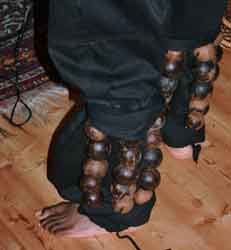 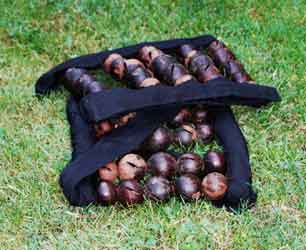
The western Lacustrine Bantu people includes the Banyoro, Batooro , and Banyankore: their complex kingdoms are believed to be the product of acculturation between two different ethnic groups, the Hima and the Bayira. The Hima are said to be the descendants of pastoralists who migrated into the region from the northeast. The Baiyra are said to be descendants of agricultural populations that preceded the Hima as cultivators in the region. Bunyoro region lies in the plateau of western Uganda, constituting about 3 per cent of the population. Its nucleus is Masindi and Hima. The Batooro region evolved out of a breakaway-segment of Bunyoro that split off an unspecified time before the nineteenth century. The Batooro and Banyoro speak closely related languages, Lutooro and Lunyoro (a Bantu language), and they share many other cultural traits. The Batooro live on Uganda's western border, south of Lake Albert and constitute about 3.2 per cent of the population. In pre-colonial times, they lived in a highly centralized kingdom like Buganda, which was stratified like the society of Baganda people.
Traditionally, a Munyoro (singular) had just one ibara (name) and one empaako (praise name) which were given to him / her shortly after birth. This name has always been a kinyoro name. Officially, the name is given by clan elders; but practically, the will of the parents is paramount in this decision. Like most African names, kinyoro names are actually words or phrases in the Runyoro language; and they have a meaning. This meaning is based upon the prevailing circumstances in the family or clan at the time of the child's birth. For example, the name Nyamayarwo (meat for Death) implies that the parents are prepared for the worst, because many of their children have already died. Names like Ndyanabo (I eat with evil people), Nyendwooha (who loves me no one), Nsekanabo (I laugh with the evil people), etc. portray the sentiments of parents very ill at ease with their neighbors. Following the introduction of Christianity in the late 17th century, a new class of names was created. It was the Christian name, given upon baptism. Many Banyoro took on English names like Charles, Henry, George, etc. for their Christian names; while others took names from the Bible, like Matayo (Matthew), Yohana (John), Ndereya (Andrew), etc. It is to be noted that Islam is an important part of Bunyoro's religious heritage; so all Banyoro of Islamic belief will have an Islamic name, in addition to their kinyoro name. Names like Muhamadi (Muhamad / Mohamed), Isimairi (Ismael), Arajabu (Rajab), Bulaimu (Ibrahim), etc. are common. There are special names given to twins and the children following twins. These names are standard. When twin boys are born, the first one to be born is Isingoma, the other Kato. The female versions are Nyangoma and Nyakato, respectively. If a person is named Kaahwa, he / she comes after twins.
Unique to Banyoro and Batooro are praise names, empaako. These names are given at the same time when a child is given its regular, kinyoro name. They are special names used to show love and respect. Children call their parents by the empaako, not the regular name. The empaako is also the salutation when the Banyoro greet each other. Instead of the Western quot "Good morning, John"; the Banyoro substitute the empaako for John. There are eleven empaako names, shared by all Banyoro and Batooro. They are Abwooli, Adyeeri, Araali, Akiiki, Atwooki, Abbooki, Apuuli, Abbala, Acaali, Ateenyi and Amooti. The official empaako of the omukama (king) is always Amooti, regardless of what it used to be before he became the omukama. Another, very special, empaako reserved for the omukama alone is Okali. Contrary to the general rule that kinyoro names have a meaning, the empaako names do not have a kinyoro meaning because they are not, real, words in the Runyoro-Rutooro language. They are words (or corruptions of words) in the Luo language, the original language of the Babiito, who invaded and colonized Bunyoro from the North. The Banyoro and Batooro people have, however, assimilated these Luo names into their language, and even attempted to append some meaning to them. For example, Ateenyi is the great serpent of River Muziizi; Abwooli is the cat; Akiiki is the savior of nations; Acaali is lightning, etc.
Every Munyoro (singular from Banyoro) belongs to a clan. The clan is the collective group of people who are descendants from the same ancestor, and are, therefore, blood relatives. Long before the tradition of kingdoms, the Banyoro lived in clan groups. Areas of the land were named after the clan that lived there. For example, Buyaga was the area of the Bayaga clan, Buruli for the Baruli clan, Bugahya for the Bagahya clan, etc. The clan is very important to a Munyoro, man or woman. It is important that one is well aware of the clan relationships on both mother's and father's side of the family. This is crucial in order to avoid in-breeding. One cannot marry in one's own clan or in that of his / her mother. Marriage to one's cousins, no matter how far removed, is not acceptable. An exemption from this rule is claimed by the princes and princesses of the kingdom. In their effort to maintain their "blue blood lines", it is not unheard of for the royals of Bunyoro, Batooro and Buganda to marry very close to their own or their mothers' clans.
- The Batembuzi Dynasty
The first kings were of the Batembuzi dynasty. Batembuzi means harbingers or pioneers. The Batembuzi and their reign are not well documented, and they are surrounded by a lot of myths and oral legends. There is very little concurrence, among scholars, regarding the Batembuzi time period in history, even the names and successive order of individual kings. It is believed that their reign dates back to the time of Africa's bronze age.
- The Babiito Dynasty
Any attempt to pinpoint the dates of this, or any other dynasty before it, is pure conjecture; as there were no written records at the time. Modern-day-historians place the beginning of the Babiito dynasty at around the time of the invasion of Banyoro by the Luo from the North. The first Mubiito (singular) king was Isingoma Mpuga Rukidi I, whose reign is placed around the 14th century.
- The Bachwezi Dynasty
The Bachwezi dynasty was followed by the Babiito dynasty of the current omukama (king) of Bunyoro-Kitara.The Bachwezi are credited with the founding of the ancient empire of Kitara; which included areas of present-day central, western, and southern Uganda; northern Tanzania, western Kenya, and eastern Congo. Very little is documented about them. Their entire reign was shrouded in mystery, so much so that they were accorded the status of demi-gods and worshipped by various clans. Many traditional gods in Batooro, Bunyoro and Buganda have typical kichwezi (adjective) names like Ndahura, Mulindwa, Wamara, Kagoro, etc.
The Bachwezi dynasty must have been very short, as supported by only three names of kings documented by historians. The Bachwezi kings were Ndahura, Mulindwa and Wamara; in this order.
In addition to founding the empire of Kitara, the Bachwezi are further credited with the introduction of the unique, long-horned Ankole cattle, coffee growing, iron smelting, and the first semblance of organized and centralized government, under the king.
No one knows what happened to the Bachwezi. About their disappearance, there is no shortage of colorful legends. One legend claims that they migrated westward and disappeared into Lake Mwitanzige (Lake Albert). There is a small crater lake in preday Fortpotal that others they disapeared into.
Another legend has them disappearing into Lake Wamala, which bears the name of the last king of the dynasty. There is a popular belief among scholars that they simply got assimilated into the indigenous populace, and are, today, the tribal groups like the Bahima of Ankole and the Batutsi of Rwanda. The Bahima and Batutsi have the elegant tall build and light complexion of the Bachwezi, and they are traditionally herders of the long-horned Ankole cattle.
Today the Kingdom of Bunyoro-Kitara is the remainder of a once powerful empire of Kitara. At the height of its glory, the empire included present-day Masindi, Hoima, Kibale, Kabarole and Kasese districts; also parts of present-day Western Kenya, Northern Tanzania and Eastern Congo. That Bunyoro-Kitara is only a skeleton of what it used to be is an absolute truth to which history can testify. One may ask how a mighty empire like Kitara, became the presently underpopulated and underdeveloped kingdom of Bunyoro-Kitara. This is the result of many years of orchestrated, intentional and malicious marginalization, dating back to the early colonial days.
The people of Bunyoro, under the reign of the mighty King Cwa II Kabalega, resisted colonial domination. Kabalega, and his well-trained army of "abarusuura"; (soldiers), put his own life on the line by mounting a fierce, bloody resistance against the powers of colonialization. On April 9th, 1899, Kabalega was captured by the invading colonial forces and was sent into exile on the Seychelles Islands. With the capture of Kabalega, the Banyoro were left in a weakened military, social and economic state, from which they have never fully recovered. Colonial persecution of the Banyoro did not stop at Kabalega's ignominious capture and exile. Acts of systematic genocide continued to be carried out against the Banyoro, by the colonialists and other foreign invaders. Colonial efforts to reduce Bunyoro to a non-entity were numerous, and they continued over a long period of time. They included invasions where masses were massacred; depopulating large tracts of fertile land and setting them aside as game reserves; enforcing the growth of crops like tobacco and cotton at the expense of food crops; sanctioning looting and pilaging of villages by invading forces, importing killer diseases like syphilis that grew to epidemic proportions; and so on.
The omukama (king) of Bunyoro-Kitara Kingdom, however, was restituted by Statute No. 8 of 1993, enacted by the Parliament of Uganda, after the monarchy had been abolished for 27 years. Unlike the pre-1967-Omukama who was a titular head of the local government of Bunyoro, the omukama, today, is a cultural leader with no governmental functions.
3. Otwenge - Alur people
- Sarah Ndagire: back vocal
- Pedson Kasume: voice, adungu, adungu bass, endingidi, engalabi, engoma, ensaasi
The word otwenge literally means the elble. It is a song of the Alur people of northwestern Uganda (West Nile), and it's commonly used to accompany Adungu Dance (literally - Bowharp Dance), which is a dance for the young talented boys and girls of their community.The song is commonly played on the adungu, and it emphasizes importance of the elble in the dance motifs, movements and general role of the dancer's body.
- Adungu - Adeudeu (bow harp - arched harp - string instument)
The adungu is a nine-string arched (bow) harp of the Alur people of northwestern Uganda. It is very similar to the tumi harp of the neighboring Kebu people, and it is also used by the Lugbara and Ondrosi tribes in this northwestern region around the Nile. The harp is used to accompany epic and lyrical songs, and is also used as a solo instrument or within ensembles. Players of arched harps have had a high social status, and are included in royal retinues. Nowadays they also play in churches.
The adungu consists of an arched neck, a wooden resonator (sound box) in which the neck is fixed, and a series of parallel strings of unequal lengths that are plucked. The strings are fixed at one end to the resonator and run at an oblique angle to the neck, where they are attached and tuned with pegs. The first, second, and third strings are tuned in octaves with the sixth, seventh, and eighth respectively. In traditional music the instrument is tuned in a pentatonic (five-note) scale, but it can also be tuned in modern style to a diatonic scale.
- West Nile; their melodies are based on the court music, and it is quiter in nature and with complex rhythms. The tuning scale is more or less diatonic for most of these tribes. In other words, it is similar to the Congolesian (Zaire) music and furthermore, it tends towards the Western African music in general..
5. Imbalu - drum rhythms from the Bagisu people
- Sarah Ndagire: voice, ullulation, handclapping (engalo)
- Pedson Kasume: voice, engoma, ensaasi
Mwaga is a ceremonial initiation dance of the Bagisu people.They believe that for a young boy to become a man, he must be circumcized, a ceremony that is reflected in the dance. Before this initiation, the young boy must dance and only then will he possess the spiritual powers without fear and he will become a man. If a man, even an elderly one, does not go through this ceremony, he will never be referred to as a man and he will never earn the respect of the community. He will actually be cursed until the spirits force him to perform this ceremony.
- Bagisu - The origin of the Bamasaaba is not known but traditions carried over generationa by oral history point at Egypt (Misiri) as the traditional homeland but this could be the similar epicenter where other migrations from the lower Nile and northwestern Ethiopia took place at the close of the millennium, approximately 900 AD. These groups, also including the Nilotics and Hamitic communities that contstitute the Hima and Tutsi peoples of western Uganda, Rwanda and Burundi. Indeed it is difficult to place the Bamaasaba among the Uganda communities because they relate to both Ugandan and Kenyan communities. The language architecture is close to the Baganda and Bakonzo of western Uganda while their cultural traits are close to the Hamitic groups of northwestern Ethiopia. The Bagisu, alternately referred to as Gisu, Bamasaba, (people of Bugisu region) are closely related to the Bakusu people of Kenya..The Babukusu of western Kenya are believed to have migrated from the Bamasaaba, particularly from areas around Bubulo, in the current Manafwa District. Many clans among the Babukusu have their origins among the Bamasaaba. Masindi Muliro, once a veteran politician and elder of the Babukusu from Kitale, was form the Bakokho clan, with its base at Sirilwa, near Bumbo in Uganda. Other clans common to both sides include Batiiru Babambo, Batiiru, Baata, and Bakitang'a. There are other clans whose names, however, are only on one side, such as Babichache and Balonja who are mainly among the Babukusu. The common cultural ties are a further indication of close relations among the two sister ethnic groups. During the Constituent Assembly that led to the 1995 Cosntitution of Uganda, Mulongo Simon, a delegate from Bubulo East, introduced Babukusu as one of the ethnic groups, acknowledging the fact that both groups, Bamasaaba and Babukusu are intertwined. Bagisu speak a dialect of the Masaba language called Lugisu (Bantu language), which is fully understandable by other dialects within the Bamasaaba group, and is also understood by the Bakusu. The term Bamasaaba is sometimes used interchangeably with the term Bagisu, even though the latter is actually a sub-group of the main Bamasaaba group.
Mountain Elgon, known locally known as Masaba (a vulcano 4'321m), the legendary father of the Bagisu people, has a long history of human occupation. The Bagisu, a Bantu speaking people, were the first settlers on the mountain's western and southwestern slopes. Traditionally agriculturalists, they began cultivating in Mt. Elgon's fertile volcanic soils in the 14th century. They have remained on the mountain's slopes up to the present day and now currently inhabit the Mbale District. They are known throughout East Africa for producing high quality Arabica coffee. About a century after the arrival of the Bagisu, the Kalenjins (a Nilotic-Hamitic group) from the north migrated to Mt. Elgon. Those who settled on the mountain called themselves the Saboat. Later, they split into several distinct groups, including the El Kony clan which roamed the forests and high heath and moorland zones. Another group, the Sebei, settled on the northern slopes of the Ugandan side of Mt. Elgon and are currently concentrated within the Kapchorwa District. Unlike the Bagisu cultivators, the Sebei or Ndorobo, are mainly pastoralists. Today the Sebei have also adapted agricultural practices such as commercial maize and wheat cultivation.
Today, the Bamasaaba inhabit the eastern districts of Sironko, Manafwa, Manjiya and Mbale etc. and western Kenya. They are a mainly agricultural people, farming millet, bananas, vegetables, honey, bamboo and sorghum on smaller holder plots. Maize became popular with the arrival of Europeans in the late 1890s. Traditional resources such as medicinal plants and water, sacred grounds and ancestral folklore, passed on orally to younger generations, all contribute to the inseparable relationship between the people and the mountain. Bamasaaba politics before the arrival of Europeans were organised in a decentralized way but maintained strong clan system that brought them together as a community. They had a strong fighting force of youths, whose pre-occupation was to herd livestock and trained in warfare (warriors). They warded off attacks from neighboring communities such as the Luo, Iteso, Elgon Masaai (Sabot and Sebei). Earlier, when the Masaai were still dominant in the eastern part of Mt Elgon, they were the traditional hotile neighbours. The dual economic activity of both crop and animal husbandry generated a resilient economy that supported their livelyhoods and developed into an indepndent cultural community that endured centuries of hostility.
The advance of the European missioneries in late 1890s, facilitated by Kakungulu, a British Muganda agent, established a base for the British colonial rule in the area. This changed drastically the geo-political settings of the Bamasaaba from then onwards. They put up a futile fight against organized elite Ganda fighters but lost their sovereignty and succumbed to foreign rule. The Church Missionary Society (CMS) led by Bishop Tucker and assisted by Kakungulu, established British and particularly Anglican system in the area, this is, improved labour, road infrastructure and established administrative units based on the Buganda Kingdom centralized system. Up to its indepndence in 1962, Bamasaaba had had several western educated systems.
The Bamasaaba are famous for their traditional male circumcision ceremonies, held every year.This ceremony is an important cultural link between the local people around Mt. Elgon. During the three-day-ceremony of dancing, visiting friends and family, feasting and receiving gifts, preceding by a couple of months of preparations, e.g. bamboo strips being handed down to the candidate by the eldest uncle, on the father's side, to symbolize the responsibility and strength needed to face the challenge of manhood, the candidate is decorated with skins and waves two black and white colobus monkey tails in the air as he is accompanied in the running across villages. A combination of sounds, including the ringing of bells attached to the candidates; fiddles, flutes, and group songs, makes this event memorable to anyone watching. Intricate rhythms are played on different traditional drums of differing pitching, and this creates and often stimulates the dancing of everyone present. The person undergoing circumcision is accompanied in the running across the villages, and at the end of it he must be strong and he is not expected to make noise (scream) during circumcision, as otherwise the family will be too embarrassed. It is of great importance for the candidate to "quiet" stand strong during the circumcision to show that he is capable and ready to become a man. The initiates are admitted into adulthood after this ceremony and are expected to begin their formal contribution to the growth of their respective communities. Unlike the Bagisu, the Sebei also circumcise women.
6. Idra Niri - Lugbara people
- Pedson Kasume: voice, adungu
Idra Niri, a mother-in-law, is sitting on a cooking stone and advaising her daughter-in-law against selfishness, sadness, envy, and arrogance at home. It educates the newly married women of the Lugbara people of West Nile on how to behave in their homes when married, and in this song the mother is directly telling off the daughter-in-law about the above mentioned issues in her home.
Gaze dance - This is a contemporary dance in the Western Nile region in North Uganda performed among the Lugbara people. It is a direct transformation of the dance movements of Lugbara dancing to contemporary trends towards the Congo (Zaire) styles of dancing.
Lugbara is an ethnic group that lives mainly in the western Nile region in North Uganda and in the adjoining area of the Democratic Republic of the Congo, which is an almost treeless plateau. They speak a Central Sudanic language similar to the language spoken by Madi, with whom they also share many cultural similarities. The Madi live in the lowlands to the east. The two groups speak nearly identical languages and have strong cultural similarities. Both grow millet, cassava, sorghum, vegetables, and a variety of root crops. Chicken, goats, and, at higher elevations, cattles are also important. Corn is grown for brewing beer, and tobacco is an important cash crop.
Mythology - All are descendants from the first creatures put on earth by spirit (the creator of men) at the beginning. Spirit created a man (gborogboro) and a woman (meme), and then domestic livestock. Meme had wild animals in her womb, so that after the gazelle had broken out, all animals followed. She also bore a boy and a girl, who reproduced themselves in pairs later on for several generations, till the Lugbara heroes, Jaki and Dribidu were born. Adroa appeared in both good and evil aspects; he was the creator god and appeared on earth as a human who was near death. He was depicted as a very tall and white man with only one half of a body, missing one eye, one leg, etc. His children were called the Adroanzi. They were nature gods of specific rivers, trees and other sacred wild areas. At night, they followed people and protected them from animals and bandits as long as they did not look over their shoulder to ensure that Adroanzi was following; if the person did so, they promptly killed him or her.
Religion - They believe that the living and the dead will be of the same lineage and are in a permanent relationship with each other. As a result, the dead are aware of the actions of the living and care about them, whom they consider as their children. However, in some circumstances, the dead send sickness to the living in order to remind them that they are acting custodians of the Lugbara lineages and their shrines. God is also associated with that relationship between the living and the dead. He is the creator of men, who long ago created the world. However, he is conceived as god in the sky, remote and good (Onyiru), and as god in the streams, close to people, and dangerous 'bad' (Onzi). While god created the world, the hero-ancestors and their descendants, the ancestors, formed their society.
History - In their location in the Nile region, the Lugbara have been subject to only sporadic colonial administration since 1900, even though the area had been leased by the British to the Etat Independant du Congo since 1894. Some Arab expeditions entered in this region in the past; however, the Lugbara were not touched by the slave trade. The Belgians advanced through the area in 1900, opening a post at Ofude, to the west of Mount Eti, that lasted for several years. Followers of a prophet, Rembe, a Kakwa living about forty miles north of Lugbara, were subsequently entrusted by the colonial administration with overseeing the relationship between the Lugbara and the colonial authorities, creating powerful chiefs that had never existed before in Lugbara. In 1908, and after the death of the Belgian King, Leopold II, the area became part of the Sudan. By 1914 the southern portion of the Lado Enclave passed to Uganda, and a station was built at Arua. The Africa Inland Mission and the Roman Catholic Verona Fathers (Comboni Missionaries) arrived in the 1920s, they opened schools, and large missions staffed by Europeans.
Symbols - Shrines to the ancestors constitute one of the visible signs of Lugbara religion. There are many different kinds, the most prominent ones, however, being those erected for a ghost of an ancestor (Orijo, or ghost house). They are made of pieces of granite formed into a house and placed under the chief wife's granary. As a ghost spirit can create trouble for the living, he can have several shrines, where sacrificial food and beer can be offered by his descendants living in a particular compound. Other shrines include those built for the ancestors, shrines for those who did not leave sons behind, shrines for the ghosts of mother's brothers, and also for women of the lineage. Stones, as part of a shrine built to the ancestors, also constitute important symbols of wealth and prestige, and they are inherited by a person's sons after his death.
Revised by Hermelinde Steiner
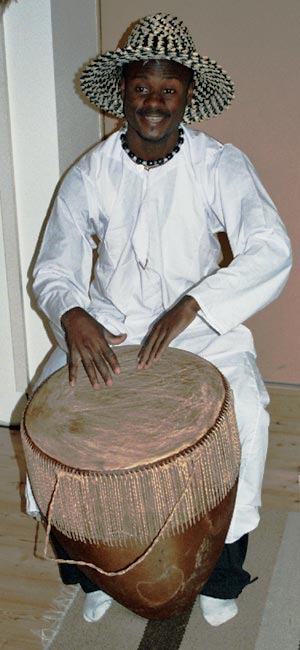
Namunjoloba
|

Endongo
|
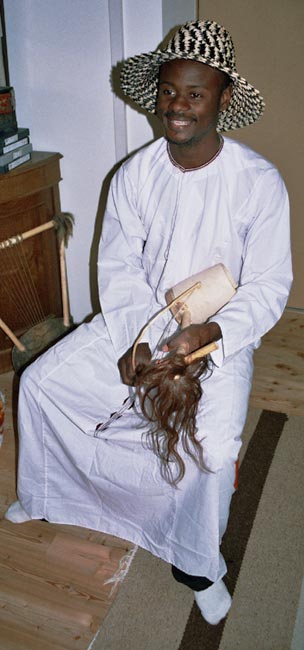
|
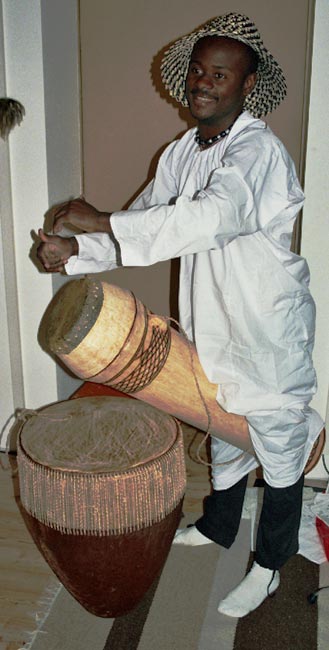
Engalabi
|
Instruments
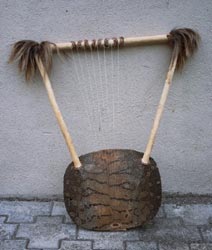

|
- Endongo - Entongoli - lyre - bowl lyre - harp lute - kora - string instrument
This is the most representative instrument of the Buganda and Busoga kingdom. Generally, the harp-lute is the instrument of the griots, or praise-singers, much as the similar kora or soron is among the people of Guinea, Ivory Coast, Senegal, Gambia, and southern Mali. It is played either solo or to accompany songs of praise. The endongo has six to eight strings which are plucked. However, the instrument's structure differs significantly from the harp proper. It is made with a large hemispherical sound-box made from a gourd, crossed by a long and straight cylindrical neck or crossbar, the lower end of which extends beyond the base and serves to hold the strings. The strings are made of ox tendons attached to plated leather rings that can be slid up and down the crossbar to tune the strings. The strings run along the two sides of a large notched bridge in the center of the sound table, dividing them into two parallel sets. The player holds the instrument in front of him, so that he may pluck the strings between the bridge and the neck with the thumbs and forefingers of each hand. The lyre has a four-sided frame consisting of the sound box, two arms, and a crossbar.
The endongo, the lyre of the Ganda, has one hole, and the entongoli, the lyre of the Songa, has two pieces of cloth, bark, or banana leaves wrapped around the frame. The strings are wound tightly around the fiber which then serves as a tuning peg. The strings are not in order of their pitches. The highest note in the scale is the third from the left and the lowest is the fifth string. Strings 7, 2, 4, 1, and 5 are tuned in octaves.
|


|
- Endingidi - Adigirgi - tube fiddle - one-string-fiddle - string instrument
This instrument is popular in the Buganda, Busoga, Ankole, Kigezi, western Nile, and Acholi regions. It consists of a single string which is attached to a flexible stick and will sometimes have a resonator. Unlike other single-string instruments, it is played with a bow. Sometimes two or more fiddles are played which blends beautifully. The fiddle has become very popular for light music.
|
Drums in African tradition bring the power that drives a performance. Music is not merely entertainment, but is ultimately bound to visual and dramatic arts as well as the larger fabric of life. Drums may be used for "talking"; that is, sending information and signals by imitating speech.
Many African languages are both tonal (that is, meaning can depend on pitch inflections) and rhythmic (that is, accents may be durational), giving speech a musical quality that may be imitated by drums and other instruments. Drumming music and dance are almost always an accompaniment for any manner of ceremony such as birth, marriages, funerals.
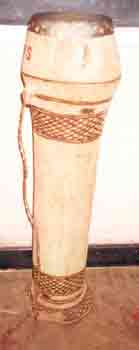 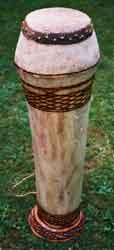
|
- Engalabi - long drum - percussion instrument
This traditional drum has a head made of reptile skin nailed to a wooden sound body. The engalbi from the Buganda region plays an important role in ceremonies and in theater. It is called "Okwabya olumbe". This is the installation of a successor to the deceased, thus the saying in Luganda (in Buganda - a Bantu dialect) "Tugenda mungalabi", meaning we are going to the engalabi, that is, long drum. The rule in playing the drum is the use of bare hands.
|
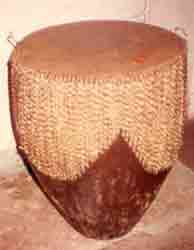
|
- Namunjoloba - Embuutu - Akaduumi - lead drum - percussion instrument

|
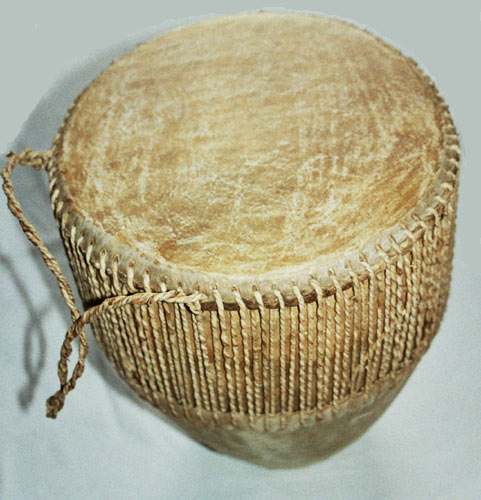
|
- Engoma - Empuunyi - Uganda drum - percussion instrument
While larger versions of this drum are traditionally hand-carved from old-growth hardwood trees, now these drums are made with pinewood slats tied together like barrels. Smaller drums are laminated and turned on a lathe and may be provided with a rope carrying the handle. All of these drums have heads made from hide held by hardwood pegs hammered into the side of the drum.
- Embuutu; big drum
- Empuunyi; bass drum
|

|
Ensaasi - Akacence - Enseege - shakers - percussion instrument
Shakers are made in pairs from gourds or shells, sometimes with stick handles, and are used to accompany other traditional instruments in Uganda. The central and northern (Alpaa) regions have shakers which that produce a continuous sound as beads move from side to side in the gourd or shell. Generally, these shakers produce sounds by many small objects, such as pebbles, rattling together inside the body.
|
Revised by Hermelinde Steiner
PageTop

|
